Project Governance and Leadership: Learnings and Experiences
VerifiedAdded on 2021/05/31
|9
|2572
|483
Report
AI Summary
This reflective report examines project governance and leadership, drawing from the book "Project Management Leadership: Building Creative Teams" by Rory Burke and Steve Barron. The report explores the roles of leaders, team members, and stakeholders in project management, emphasizing the importance of leadership skills, technical and management skills, and project entrepreneurship skills. It discusses the significance of stakeholder involvement, interdisciplinary teams, and capacity management in achieving project success. The report also highlights the importance of project management plans and their applicability in complex situations. Furthermore, it provides a practical example of applying these learnings to a charity event, demonstrating the impact of leadership, teamwork, and effective planning. The conclusion underscores the essential role of project management and leadership skills for business success.
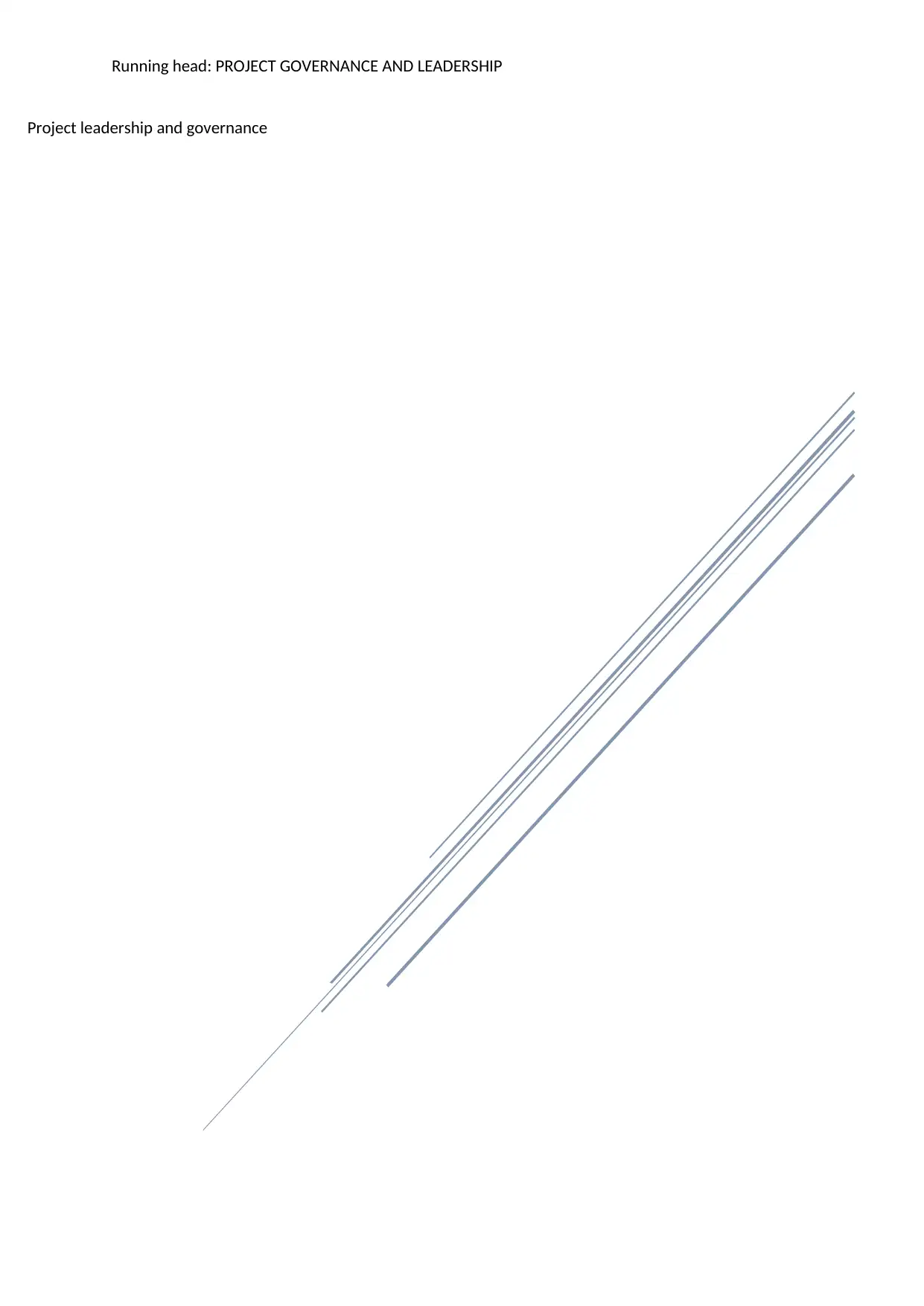
Running head: PROJECT GOVERNANCE AND LEADERSHIP
Project leadership and governance
Project leadership and governance
Paraphrase This Document
Need a fresh take? Get an instant paraphrase of this document with our AI Paraphraser
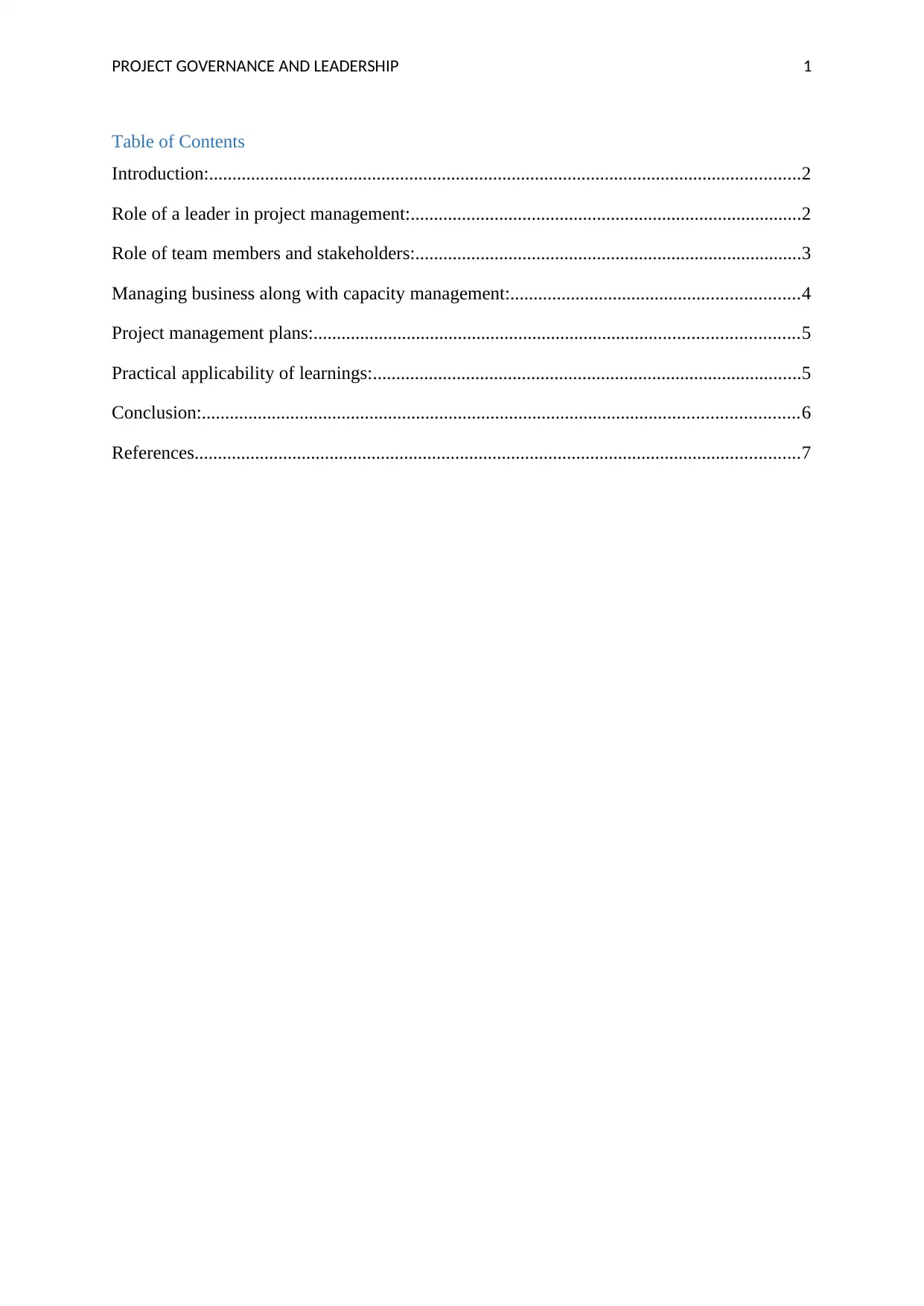
PROJECT GOVERNANCE AND LEADERSHIP 1
Table of Contents
Introduction:...............................................................................................................................2
Role of a leader in project management:....................................................................................2
Role of team members and stakeholders:...................................................................................3
Managing business along with capacity management:..............................................................4
Project management plans:........................................................................................................5
Practical applicability of learnings:............................................................................................5
Conclusion:................................................................................................................................6
References..................................................................................................................................7
Table of Contents
Introduction:...............................................................................................................................2
Role of a leader in project management:....................................................................................2
Role of team members and stakeholders:...................................................................................3
Managing business along with capacity management:..............................................................4
Project management plans:........................................................................................................5
Practical applicability of learnings:............................................................................................5
Conclusion:................................................................................................................................6
References..................................................................................................................................7
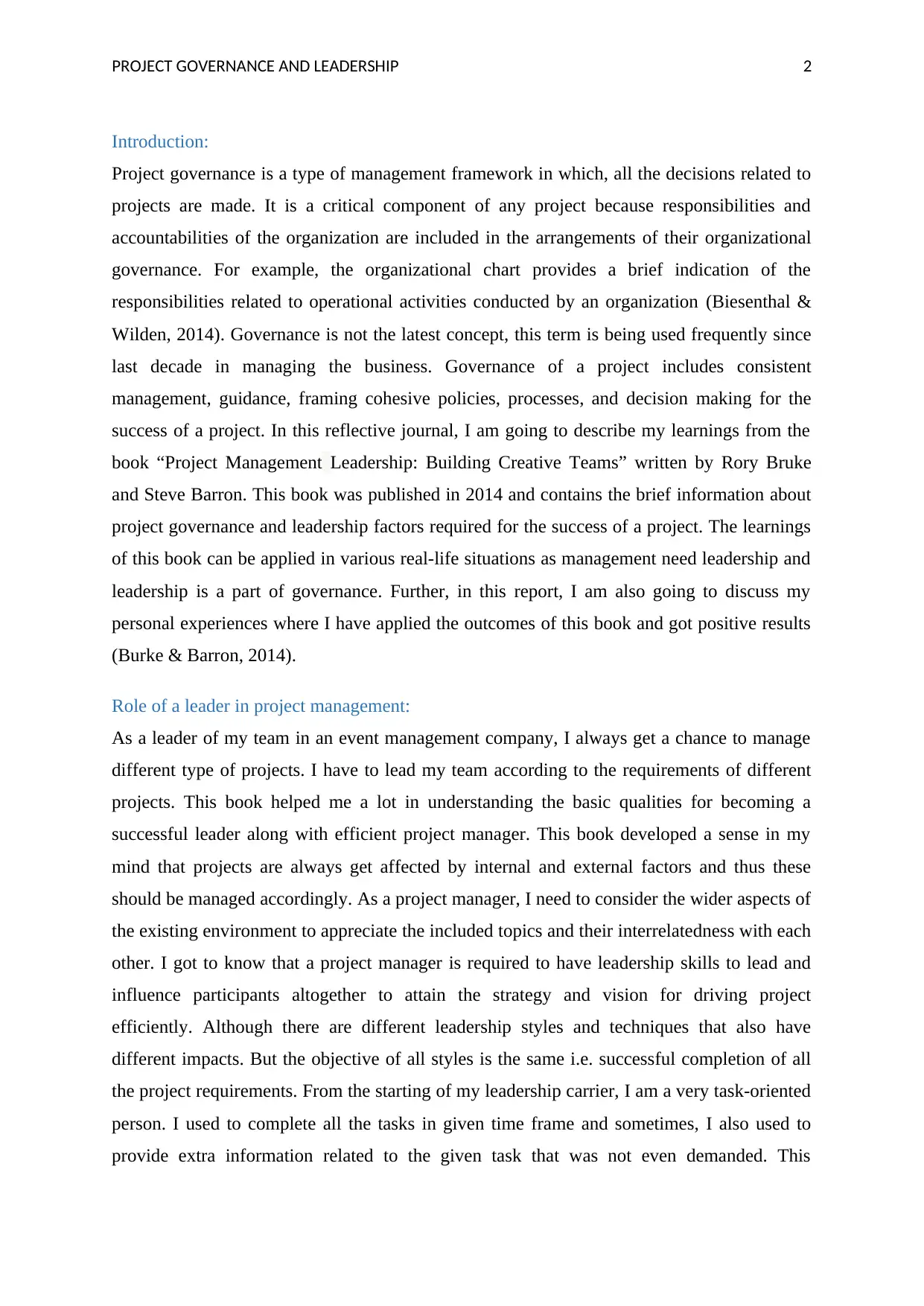
PROJECT GOVERNANCE AND LEADERSHIP 2
Introduction:
Project governance is a type of management framework in which, all the decisions related to
projects are made. It is a critical component of any project because responsibilities and
accountabilities of the organization are included in the arrangements of their organizational
governance. For example, the organizational chart provides a brief indication of the
responsibilities related to operational activities conducted by an organization (Biesenthal &
Wilden, 2014). Governance is not the latest concept, this term is being used frequently since
last decade in managing the business. Governance of a project includes consistent
management, guidance, framing cohesive policies, processes, and decision making for the
success of a project. In this reflective journal, I am going to describe my learnings from the
book “Project Management Leadership: Building Creative Teams” written by Rory Bruke
and Steve Barron. This book was published in 2014 and contains the brief information about
project governance and leadership factors required for the success of a project. The learnings
of this book can be applied in various real-life situations as management need leadership and
leadership is a part of governance. Further, in this report, I am also going to discuss my
personal experiences where I have applied the outcomes of this book and got positive results
(Burke & Barron, 2014).
Role of a leader in project management:
As a leader of my team in an event management company, I always get a chance to manage
different type of projects. I have to lead my team according to the requirements of different
projects. This book helped me a lot in understanding the basic qualities for becoming a
successful leader along with efficient project manager. This book developed a sense in my
mind that projects are always get affected by internal and external factors and thus these
should be managed accordingly. As a project manager, I need to consider the wider aspects of
the existing environment to appreciate the included topics and their interrelatedness with each
other. I got to know that a project manager is required to have leadership skills to lead and
influence participants altogether to attain the strategy and vision for driving project
efficiently. Although there are different leadership styles and techniques that also have
different impacts. But the objective of all styles is the same i.e. successful completion of all
the project requirements. From the starting of my leadership carrier, I am a very task-oriented
person. I used to complete all the tasks in given time frame and sometimes, I also used to
provide extra information related to the given task that was not even demanded. This
Introduction:
Project governance is a type of management framework in which, all the decisions related to
projects are made. It is a critical component of any project because responsibilities and
accountabilities of the organization are included in the arrangements of their organizational
governance. For example, the organizational chart provides a brief indication of the
responsibilities related to operational activities conducted by an organization (Biesenthal &
Wilden, 2014). Governance is not the latest concept, this term is being used frequently since
last decade in managing the business. Governance of a project includes consistent
management, guidance, framing cohesive policies, processes, and decision making for the
success of a project. In this reflective journal, I am going to describe my learnings from the
book “Project Management Leadership: Building Creative Teams” written by Rory Bruke
and Steve Barron. This book was published in 2014 and contains the brief information about
project governance and leadership factors required for the success of a project. The learnings
of this book can be applied in various real-life situations as management need leadership and
leadership is a part of governance. Further, in this report, I am also going to discuss my
personal experiences where I have applied the outcomes of this book and got positive results
(Burke & Barron, 2014).
Role of a leader in project management:
As a leader of my team in an event management company, I always get a chance to manage
different type of projects. I have to lead my team according to the requirements of different
projects. This book helped me a lot in understanding the basic qualities for becoming a
successful leader along with efficient project manager. This book developed a sense in my
mind that projects are always get affected by internal and external factors and thus these
should be managed accordingly. As a project manager, I need to consider the wider aspects of
the existing environment to appreciate the included topics and their interrelatedness with each
other. I got to know that a project manager is required to have leadership skills to lead and
influence participants altogether to attain the strategy and vision for driving project
efficiently. Although there are different leadership styles and techniques that also have
different impacts. But the objective of all styles is the same i.e. successful completion of all
the project requirements. From the starting of my leadership carrier, I am a very task-oriented
person. I used to complete all the tasks in given time frame and sometimes, I also used to
provide extra information related to the given task that was not even demanded. This
⊘ This is a preview!⊘
Do you want full access?
Subscribe today to unlock all pages.

Trusted by 1+ million students worldwide
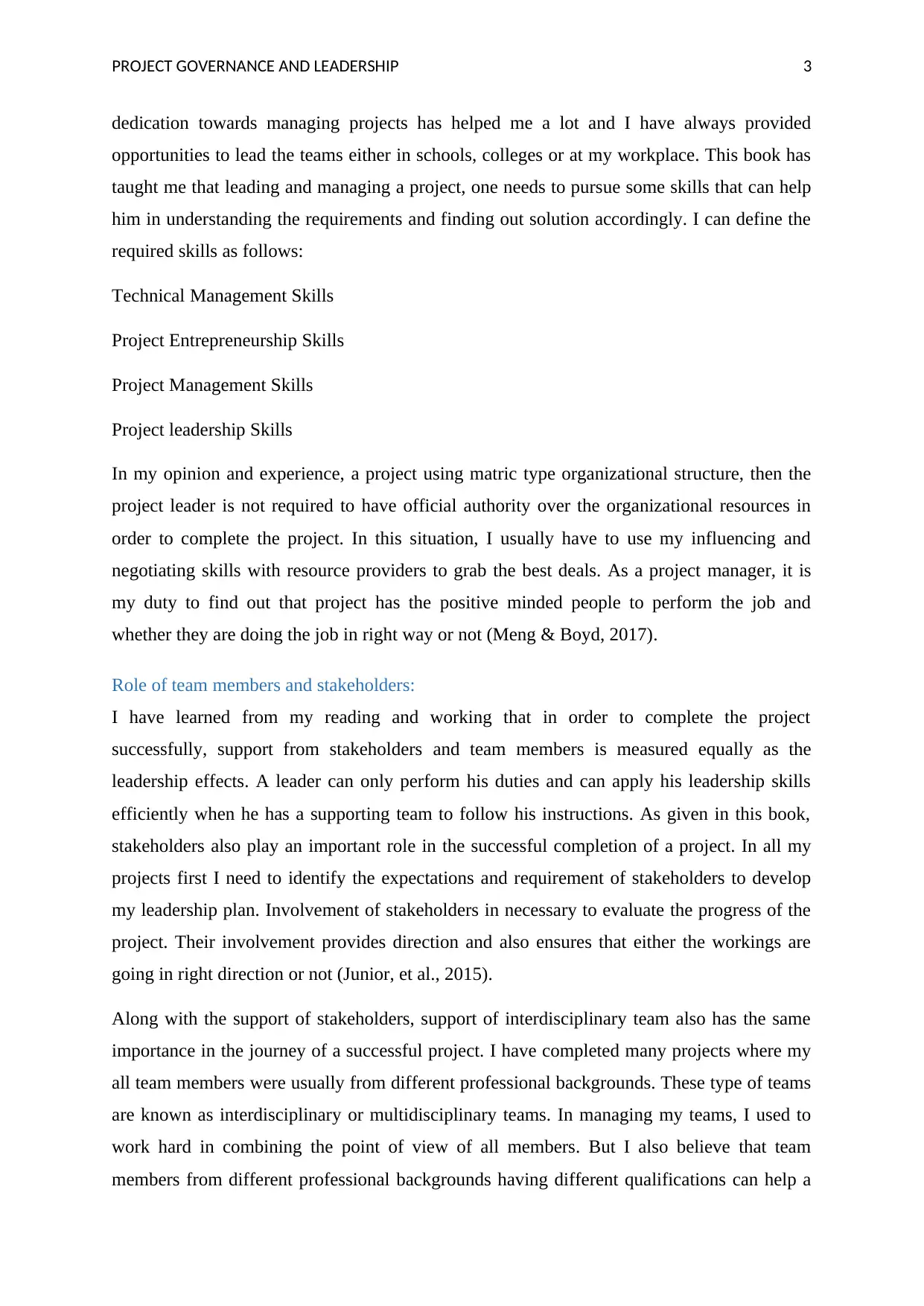
PROJECT GOVERNANCE AND LEADERSHIP 3
dedication towards managing projects has helped me a lot and I have always provided
opportunities to lead the teams either in schools, colleges or at my workplace. This book has
taught me that leading and managing a project, one needs to pursue some skills that can help
him in understanding the requirements and finding out solution accordingly. I can define the
required skills as follows:
Technical Management Skills
Project Entrepreneurship Skills
Project Management Skills
Project leadership Skills
In my opinion and experience, a project using matric type organizational structure, then the
project leader is not required to have official authority over the organizational resources in
order to complete the project. In this situation, I usually have to use my influencing and
negotiating skills with resource providers to grab the best deals. As a project manager, it is
my duty to find out that project has the positive minded people to perform the job and
whether they are doing the job in right way or not (Meng & Boyd, 2017).
Role of team members and stakeholders:
I have learned from my reading and working that in order to complete the project
successfully, support from stakeholders and team members is measured equally as the
leadership effects. A leader can only perform his duties and can apply his leadership skills
efficiently when he has a supporting team to follow his instructions. As given in this book,
stakeholders also play an important role in the successful completion of a project. In all my
projects first I need to identify the expectations and requirement of stakeholders to develop
my leadership plan. Involvement of stakeholders in necessary to evaluate the progress of the
project. Their involvement provides direction and also ensures that either the workings are
going in right direction or not (Junior, et al., 2015).
Along with the support of stakeholders, support of interdisciplinary team also has the same
importance in the journey of a successful project. I have completed many projects where my
all team members were usually from different professional backgrounds. These type of teams
are known as interdisciplinary or multidisciplinary teams. In managing my teams, I used to
work hard in combining the point of view of all members. But I also believe that team
members from different professional backgrounds having different qualifications can help a
dedication towards managing projects has helped me a lot and I have always provided
opportunities to lead the teams either in schools, colleges or at my workplace. This book has
taught me that leading and managing a project, one needs to pursue some skills that can help
him in understanding the requirements and finding out solution accordingly. I can define the
required skills as follows:
Technical Management Skills
Project Entrepreneurship Skills
Project Management Skills
Project leadership Skills
In my opinion and experience, a project using matric type organizational structure, then the
project leader is not required to have official authority over the organizational resources in
order to complete the project. In this situation, I usually have to use my influencing and
negotiating skills with resource providers to grab the best deals. As a project manager, it is
my duty to find out that project has the positive minded people to perform the job and
whether they are doing the job in right way or not (Meng & Boyd, 2017).
Role of team members and stakeholders:
I have learned from my reading and working that in order to complete the project
successfully, support from stakeholders and team members is measured equally as the
leadership effects. A leader can only perform his duties and can apply his leadership skills
efficiently when he has a supporting team to follow his instructions. As given in this book,
stakeholders also play an important role in the successful completion of a project. In all my
projects first I need to identify the expectations and requirement of stakeholders to develop
my leadership plan. Involvement of stakeholders in necessary to evaluate the progress of the
project. Their involvement provides direction and also ensures that either the workings are
going in right direction or not (Junior, et al., 2015).
Along with the support of stakeholders, support of interdisciplinary team also has the same
importance in the journey of a successful project. I have completed many projects where my
all team members were usually from different professional backgrounds. These type of teams
are known as interdisciplinary or multidisciplinary teams. In managing my teams, I used to
work hard in combining the point of view of all members. But I also believe that team
members from different professional backgrounds having different qualifications can help a
Paraphrase This Document
Need a fresh take? Get an instant paraphrase of this document with our AI Paraphraser
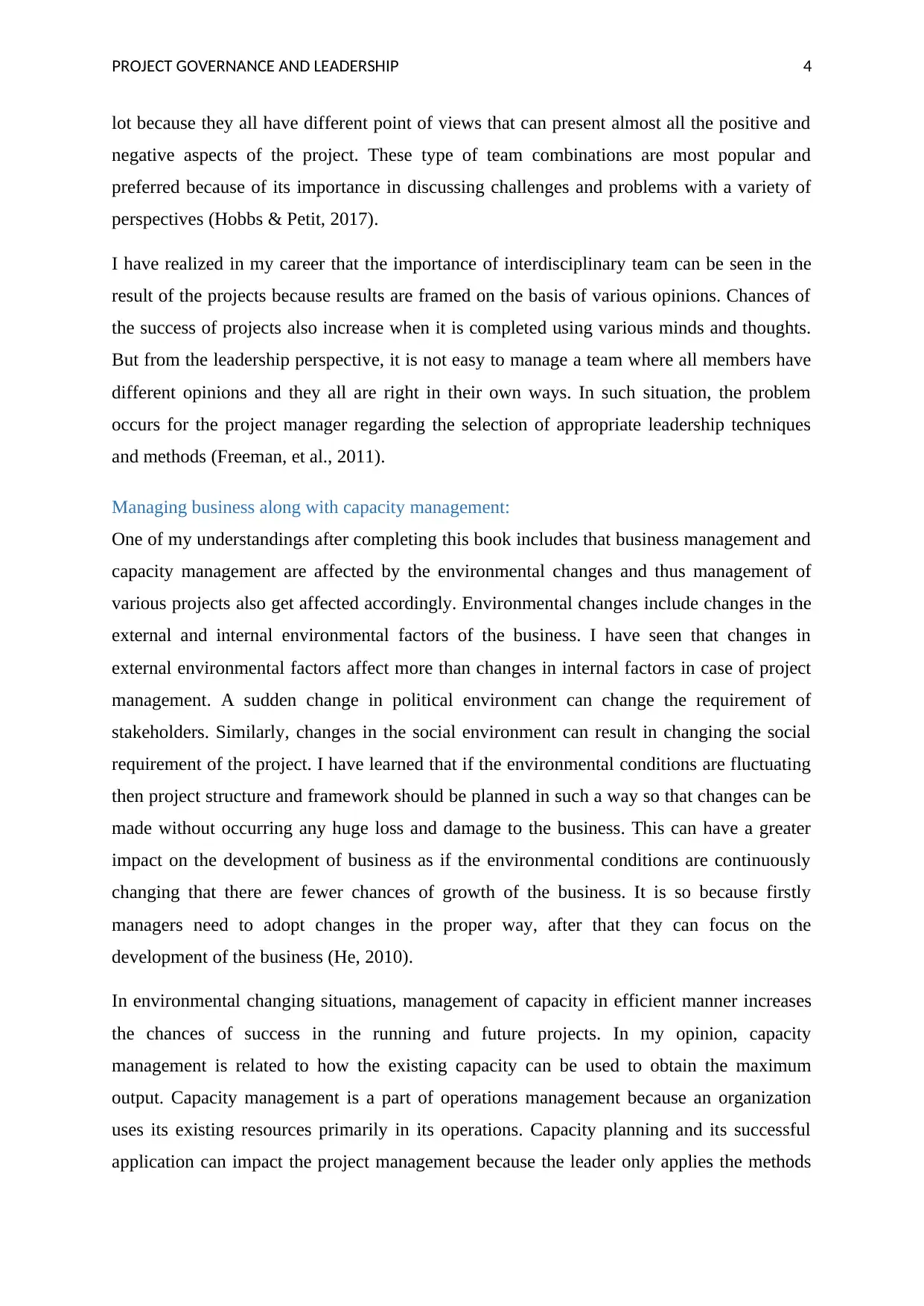
PROJECT GOVERNANCE AND LEADERSHIP 4
lot because they all have different point of views that can present almost all the positive and
negative aspects of the project. These type of team combinations are most popular and
preferred because of its importance in discussing challenges and problems with a variety of
perspectives (Hobbs & Petit, 2017).
I have realized in my career that the importance of interdisciplinary team can be seen in the
result of the projects because results are framed on the basis of various opinions. Chances of
the success of projects also increase when it is completed using various minds and thoughts.
But from the leadership perspective, it is not easy to manage a team where all members have
different opinions and they all are right in their own ways. In such situation, the problem
occurs for the project manager regarding the selection of appropriate leadership techniques
and methods (Freeman, et al., 2011).
Managing business along with capacity management:
One of my understandings after completing this book includes that business management and
capacity management are affected by the environmental changes and thus management of
various projects also get affected accordingly. Environmental changes include changes in the
external and internal environmental factors of the business. I have seen that changes in
external environmental factors affect more than changes in internal factors in case of project
management. A sudden change in political environment can change the requirement of
stakeholders. Similarly, changes in the social environment can result in changing the social
requirement of the project. I have learned that if the environmental conditions are fluctuating
then project structure and framework should be planned in such a way so that changes can be
made without occurring any huge loss and damage to the business. This can have a greater
impact on the development of business as if the environmental conditions are continuously
changing that there are fewer chances of growth of the business. It is so because firstly
managers need to adopt changes in the proper way, after that they can focus on the
development of the business (He, 2010).
In environmental changing situations, management of capacity in efficient manner increases
the chances of success in the running and future projects. In my opinion, capacity
management is related to how the existing capacity can be used to obtain the maximum
output. Capacity management is a part of operations management because an organization
uses its existing resources primarily in its operations. Capacity planning and its successful
application can impact the project management because the leader only applies the methods
lot because they all have different point of views that can present almost all the positive and
negative aspects of the project. These type of team combinations are most popular and
preferred because of its importance in discussing challenges and problems with a variety of
perspectives (Hobbs & Petit, 2017).
I have realized in my career that the importance of interdisciplinary team can be seen in the
result of the projects because results are framed on the basis of various opinions. Chances of
the success of projects also increase when it is completed using various minds and thoughts.
But from the leadership perspective, it is not easy to manage a team where all members have
different opinions and they all are right in their own ways. In such situation, the problem
occurs for the project manager regarding the selection of appropriate leadership techniques
and methods (Freeman, et al., 2011).
Managing business along with capacity management:
One of my understandings after completing this book includes that business management and
capacity management are affected by the environmental changes and thus management of
various projects also get affected accordingly. Environmental changes include changes in the
external and internal environmental factors of the business. I have seen that changes in
external environmental factors affect more than changes in internal factors in case of project
management. A sudden change in political environment can change the requirement of
stakeholders. Similarly, changes in the social environment can result in changing the social
requirement of the project. I have learned that if the environmental conditions are fluctuating
then project structure and framework should be planned in such a way so that changes can be
made without occurring any huge loss and damage to the business. This can have a greater
impact on the development of business as if the environmental conditions are continuously
changing that there are fewer chances of growth of the business. It is so because firstly
managers need to adopt changes in the proper way, after that they can focus on the
development of the business (He, 2010).
In environmental changing situations, management of capacity in efficient manner increases
the chances of success in the running and future projects. In my opinion, capacity
management is related to how the existing capacity can be used to obtain the maximum
output. Capacity management is a part of operations management because an organization
uses its existing resources primarily in its operations. Capacity planning and its successful
application can impact the project management because the leader only applies the methods
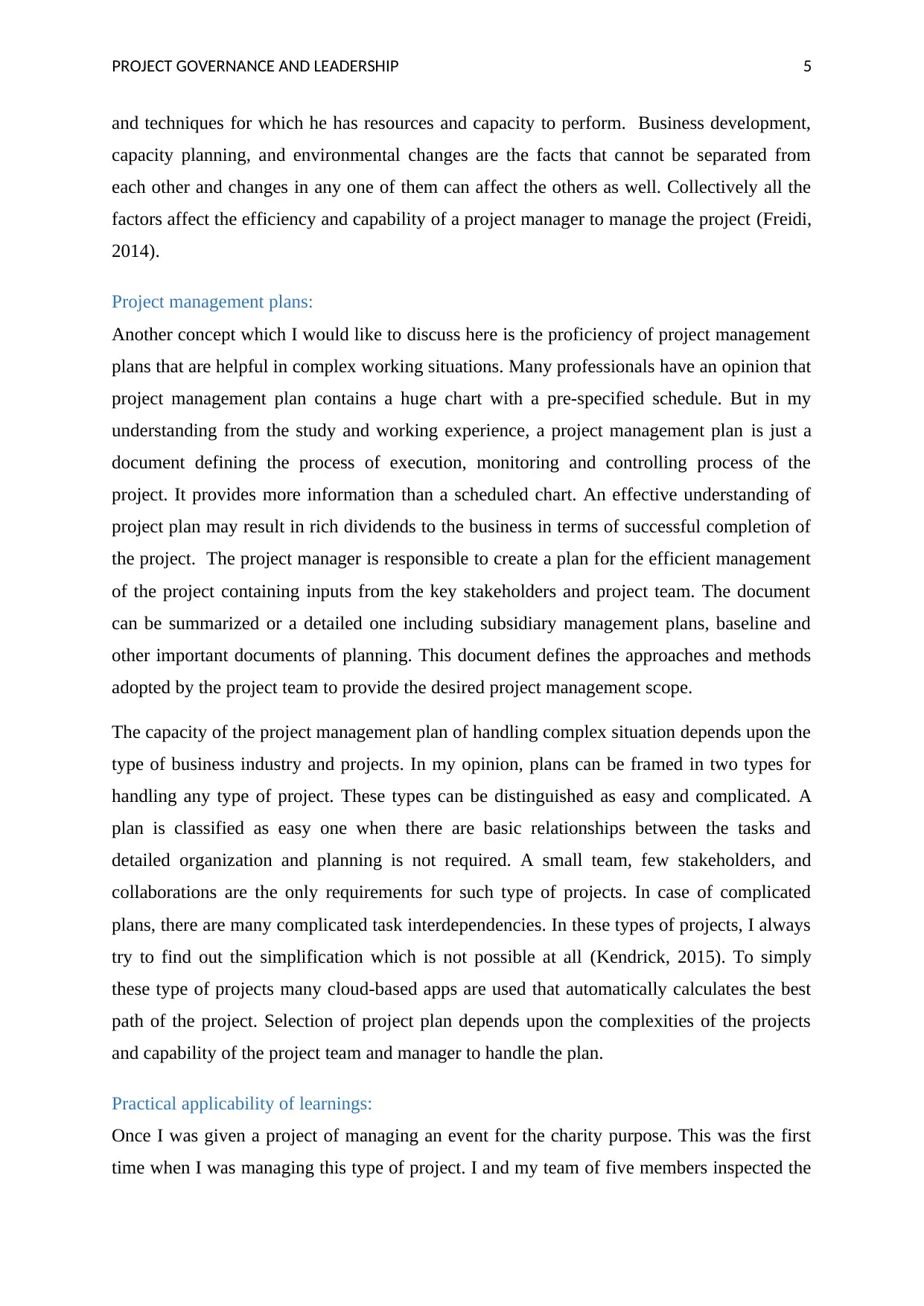
PROJECT GOVERNANCE AND LEADERSHIP 5
and techniques for which he has resources and capacity to perform. Business development,
capacity planning, and environmental changes are the facts that cannot be separated from
each other and changes in any one of them can affect the others as well. Collectively all the
factors affect the efficiency and capability of a project manager to manage the project (Freidi,
2014).
Project management plans:
Another concept which I would like to discuss here is the proficiency of project management
plans that are helpful in complex working situations. Many professionals have an opinion that
project management plan contains a huge chart with a pre-specified schedule. But in my
understanding from the study and working experience, a project management plan is just a
document defining the process of execution, monitoring and controlling process of the
project. It provides more information than a scheduled chart. An effective understanding of
project plan may result in rich dividends to the business in terms of successful completion of
the project. The project manager is responsible to create a plan for the efficient management
of the project containing inputs from the key stakeholders and project team. The document
can be summarized or a detailed one including subsidiary management plans, baseline and
other important documents of planning. This document defines the approaches and methods
adopted by the project team to provide the desired project management scope.
The capacity of the project management plan of handling complex situation depends upon the
type of business industry and projects. In my opinion, plans can be framed in two types for
handling any type of project. These types can be distinguished as easy and complicated. A
plan is classified as easy one when there are basic relationships between the tasks and
detailed organization and planning is not required. A small team, few stakeholders, and
collaborations are the only requirements for such type of projects. In case of complicated
plans, there are many complicated task interdependencies. In these types of projects, I always
try to find out the simplification which is not possible at all (Kendrick, 2015). To simply
these type of projects many cloud-based apps are used that automatically calculates the best
path of the project. Selection of project plan depends upon the complexities of the projects
and capability of the project team and manager to handle the plan.
Practical applicability of learnings:
Once I was given a project of managing an event for the charity purpose. This was the first
time when I was managing this type of project. I and my team of five members inspected the
and techniques for which he has resources and capacity to perform. Business development,
capacity planning, and environmental changes are the facts that cannot be separated from
each other and changes in any one of them can affect the others as well. Collectively all the
factors affect the efficiency and capability of a project manager to manage the project (Freidi,
2014).
Project management plans:
Another concept which I would like to discuss here is the proficiency of project management
plans that are helpful in complex working situations. Many professionals have an opinion that
project management plan contains a huge chart with a pre-specified schedule. But in my
understanding from the study and working experience, a project management plan is just a
document defining the process of execution, monitoring and controlling process of the
project. It provides more information than a scheduled chart. An effective understanding of
project plan may result in rich dividends to the business in terms of successful completion of
the project. The project manager is responsible to create a plan for the efficient management
of the project containing inputs from the key stakeholders and project team. The document
can be summarized or a detailed one including subsidiary management plans, baseline and
other important documents of planning. This document defines the approaches and methods
adopted by the project team to provide the desired project management scope.
The capacity of the project management plan of handling complex situation depends upon the
type of business industry and projects. In my opinion, plans can be framed in two types for
handling any type of project. These types can be distinguished as easy and complicated. A
plan is classified as easy one when there are basic relationships between the tasks and
detailed organization and planning is not required. A small team, few stakeholders, and
collaborations are the only requirements for such type of projects. In case of complicated
plans, there are many complicated task interdependencies. In these types of projects, I always
try to find out the simplification which is not possible at all (Kendrick, 2015). To simply
these type of projects many cloud-based apps are used that automatically calculates the best
path of the project. Selection of project plan depends upon the complexities of the projects
and capability of the project team and manager to handle the plan.
Practical applicability of learnings:
Once I was given a project of managing an event for the charity purpose. This was the first
time when I was managing this type of project. I and my team of five members inspected the
⊘ This is a preview!⊘
Do you want full access?
Subscribe today to unlock all pages.

Trusted by 1+ million students worldwide
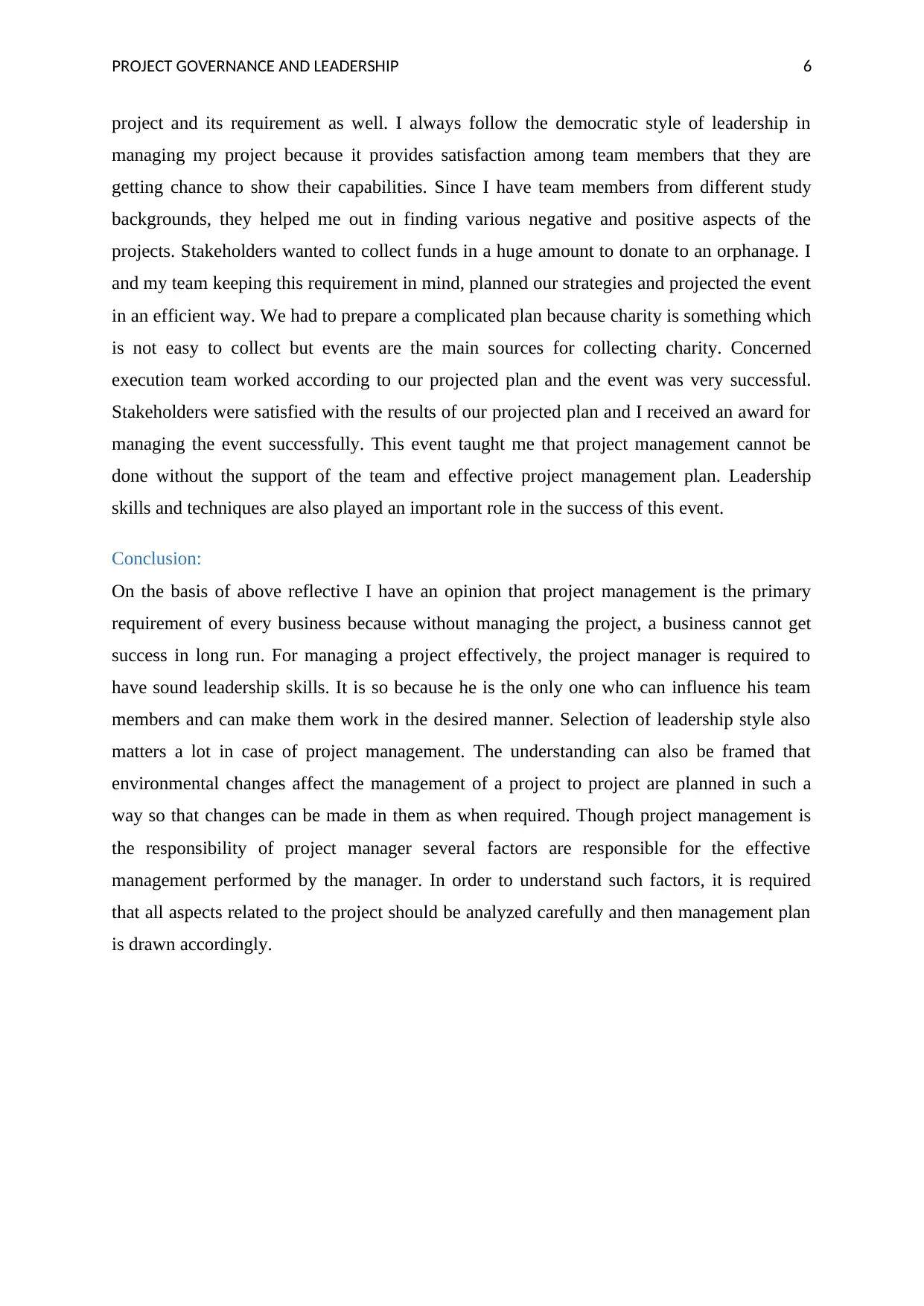
PROJECT GOVERNANCE AND LEADERSHIP 6
project and its requirement as well. I always follow the democratic style of leadership in
managing my project because it provides satisfaction among team members that they are
getting chance to show their capabilities. Since I have team members from different study
backgrounds, they helped me out in finding various negative and positive aspects of the
projects. Stakeholders wanted to collect funds in a huge amount to donate to an orphanage. I
and my team keeping this requirement in mind, planned our strategies and projected the event
in an efficient way. We had to prepare a complicated plan because charity is something which
is not easy to collect but events are the main sources for collecting charity. Concerned
execution team worked according to our projected plan and the event was very successful.
Stakeholders were satisfied with the results of our projected plan and I received an award for
managing the event successfully. This event taught me that project management cannot be
done without the support of the team and effective project management plan. Leadership
skills and techniques are also played an important role in the success of this event.
Conclusion:
On the basis of above reflective I have an opinion that project management is the primary
requirement of every business because without managing the project, a business cannot get
success in long run. For managing a project effectively, the project manager is required to
have sound leadership skills. It is so because he is the only one who can influence his team
members and can make them work in the desired manner. Selection of leadership style also
matters a lot in case of project management. The understanding can also be framed that
environmental changes affect the management of a project to project are planned in such a
way so that changes can be made in them as when required. Though project management is
the responsibility of project manager several factors are responsible for the effective
management performed by the manager. In order to understand such factors, it is required
that all aspects related to the project should be analyzed carefully and then management plan
is drawn accordingly.
project and its requirement as well. I always follow the democratic style of leadership in
managing my project because it provides satisfaction among team members that they are
getting chance to show their capabilities. Since I have team members from different study
backgrounds, they helped me out in finding various negative and positive aspects of the
projects. Stakeholders wanted to collect funds in a huge amount to donate to an orphanage. I
and my team keeping this requirement in mind, planned our strategies and projected the event
in an efficient way. We had to prepare a complicated plan because charity is something which
is not easy to collect but events are the main sources for collecting charity. Concerned
execution team worked according to our projected plan and the event was very successful.
Stakeholders were satisfied with the results of our projected plan and I received an award for
managing the event successfully. This event taught me that project management cannot be
done without the support of the team and effective project management plan. Leadership
skills and techniques are also played an important role in the success of this event.
Conclusion:
On the basis of above reflective I have an opinion that project management is the primary
requirement of every business because without managing the project, a business cannot get
success in long run. For managing a project effectively, the project manager is required to
have sound leadership skills. It is so because he is the only one who can influence his team
members and can make them work in the desired manner. Selection of leadership style also
matters a lot in case of project management. The understanding can also be framed that
environmental changes affect the management of a project to project are planned in such a
way so that changes can be made in them as when required. Though project management is
the responsibility of project manager several factors are responsible for the effective
management performed by the manager. In order to understand such factors, it is required
that all aspects related to the project should be analyzed carefully and then management plan
is drawn accordingly.
Paraphrase This Document
Need a fresh take? Get an instant paraphrase of this document with our AI Paraphraser
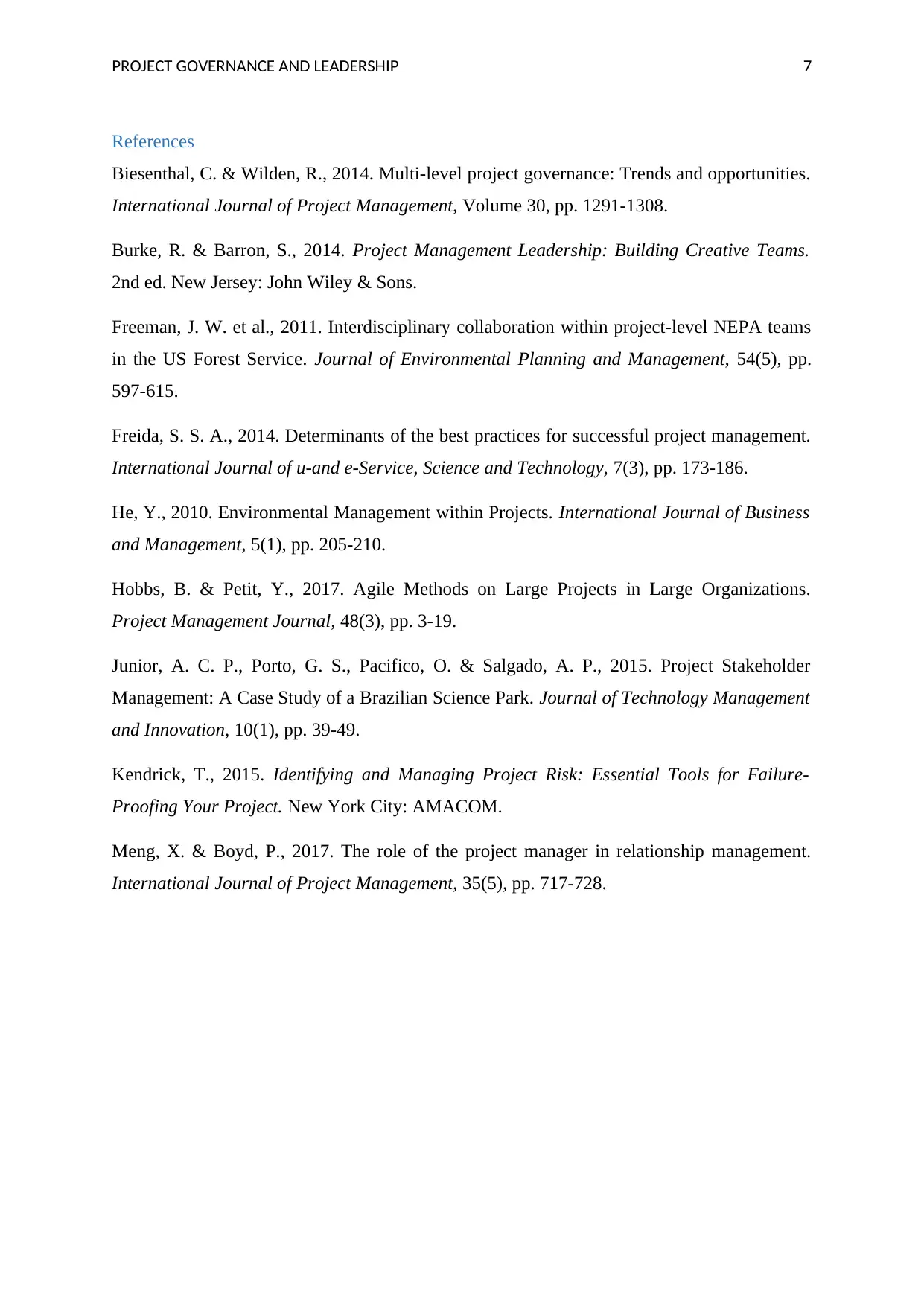
PROJECT GOVERNANCE AND LEADERSHIP 7
References
Biesenthal, C. & Wilden, R., 2014. Multi-level project governance: Trends and opportunities.
International Journal of Project Management, Volume 30, pp. 1291-1308.
Burke, R. & Barron, S., 2014. Project Management Leadership: Building Creative Teams.
2nd ed. New Jersey: John Wiley & Sons.
Freeman, J. W. et al., 2011. Interdisciplinary collaboration within project-level NEPA teams
in the US Forest Service. Journal of Environmental Planning and Management, 54(5), pp.
597-615.
Freida, S. S. A., 2014. Determinants of the best practices for successful project management.
International Journal of u-and e-Service, Science and Technology, 7(3), pp. 173-186.
He, Y., 2010. Environmental Management within Projects. International Journal of Business
and Management, 5(1), pp. 205-210.
Hobbs, B. & Petit, Y., 2017. Agile Methods on Large Projects in Large Organizations.
Project Management Journal, 48(3), pp. 3-19.
Junior, A. C. P., Porto, G. S., Pacifico, O. & Salgado, A. P., 2015. Project Stakeholder
Management: A Case Study of a Brazilian Science Park. Journal of Technology Management
and Innovation, 10(1), pp. 39-49.
Kendrick, T., 2015. Identifying and Managing Project Risk: Essential Tools for Failure-
Proofing Your Project. New York City: AMACOM.
Meng, X. & Boyd, P., 2017. The role of the project manager in relationship management.
International Journal of Project Management, 35(5), pp. 717-728.
References
Biesenthal, C. & Wilden, R., 2014. Multi-level project governance: Trends and opportunities.
International Journal of Project Management, Volume 30, pp. 1291-1308.
Burke, R. & Barron, S., 2014. Project Management Leadership: Building Creative Teams.
2nd ed. New Jersey: John Wiley & Sons.
Freeman, J. W. et al., 2011. Interdisciplinary collaboration within project-level NEPA teams
in the US Forest Service. Journal of Environmental Planning and Management, 54(5), pp.
597-615.
Freida, S. S. A., 2014. Determinants of the best practices for successful project management.
International Journal of u-and e-Service, Science and Technology, 7(3), pp. 173-186.
He, Y., 2010. Environmental Management within Projects. International Journal of Business
and Management, 5(1), pp. 205-210.
Hobbs, B. & Petit, Y., 2017. Agile Methods on Large Projects in Large Organizations.
Project Management Journal, 48(3), pp. 3-19.
Junior, A. C. P., Porto, G. S., Pacifico, O. & Salgado, A. P., 2015. Project Stakeholder
Management: A Case Study of a Brazilian Science Park. Journal of Technology Management
and Innovation, 10(1), pp. 39-49.
Kendrick, T., 2015. Identifying and Managing Project Risk: Essential Tools for Failure-
Proofing Your Project. New York City: AMACOM.
Meng, X. & Boyd, P., 2017. The role of the project manager in relationship management.
International Journal of Project Management, 35(5), pp. 717-728.

PROJECT GOVERNANCE AND LEADERSHIP 8
⊘ This is a preview!⊘
Do you want full access?
Subscribe today to unlock all pages.

Trusted by 1+ million students worldwide
1 out of 9
Related Documents
Your All-in-One AI-Powered Toolkit for Academic Success.
+13062052269
info@desklib.com
Available 24*7 on WhatsApp / Email
![[object Object]](/_next/static/media/star-bottom.7253800d.svg)
Unlock your academic potential
Copyright © 2020–2025 A2Z Services. All Rights Reserved. Developed and managed by ZUCOL.




